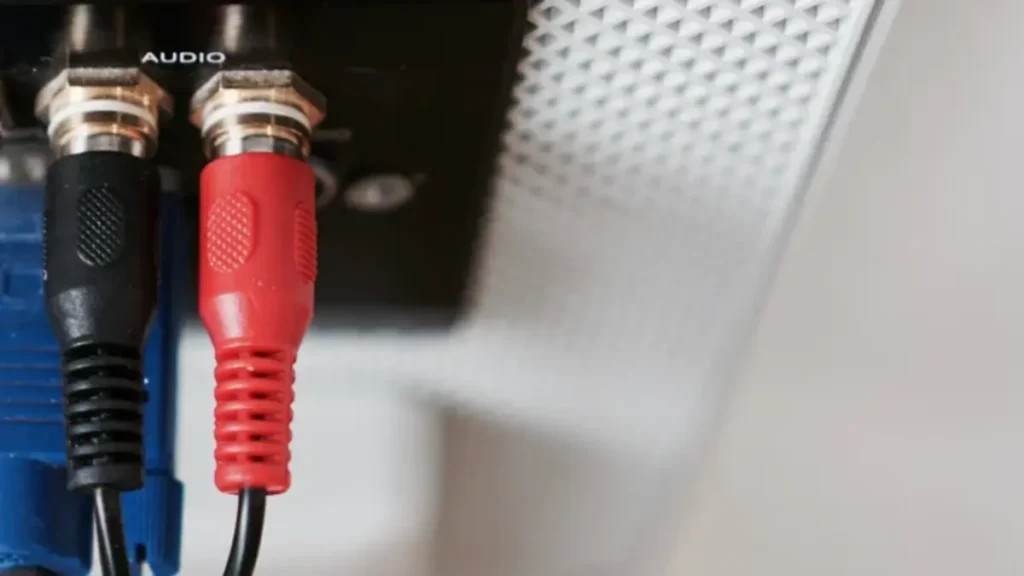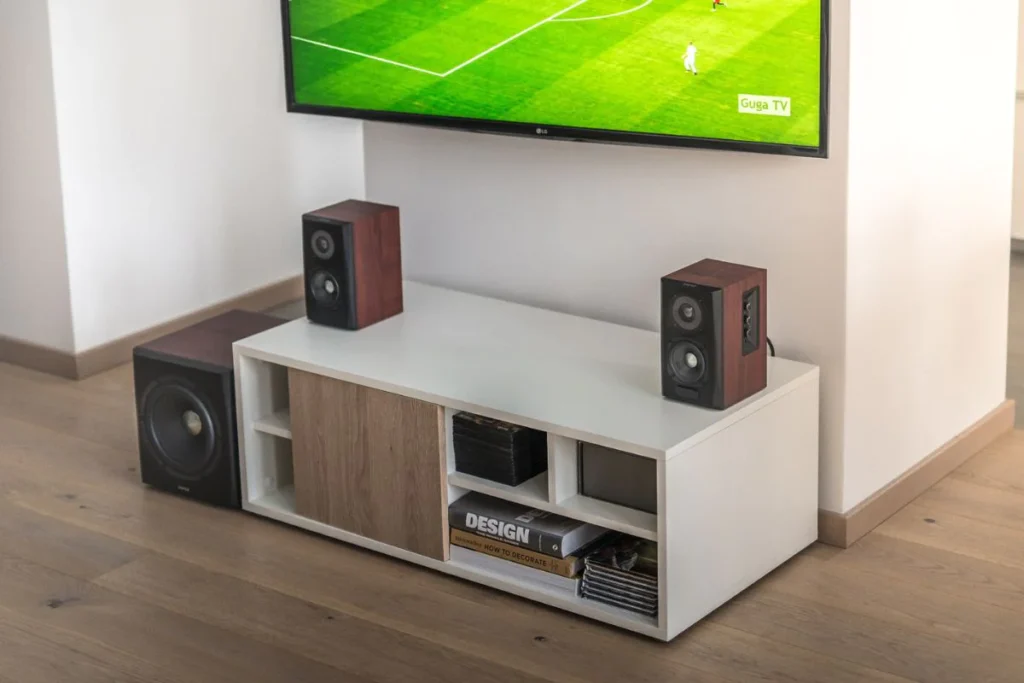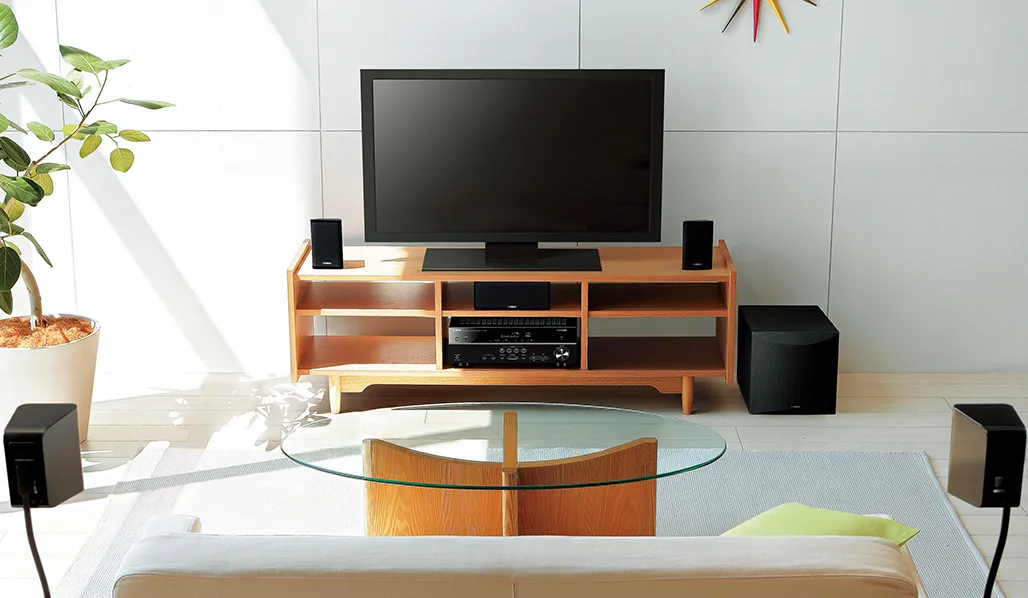Transform your living room into a cinematic sanctuary with an immersive audio experience that matches your high-definition visuals. If the thin sound from your TV’s built-in speakers leaves you longing for depth and clarity, pairing it with bookshelf speakers is your ticket to audio bliss. Here’s a simple, step-by-step guide to get you connected and enveloped in sound.
Connecting Bookshelf Speakers to Your TV
You can easily connect your Bookshelf Speakers to Your TV through 2 main ways : wired and wireless connection each of these method is explained below:
- Wired Connection
For a wired connection, you need to follow the following steps to connect your bookshelf speakers to your TV:

Step 1: Accessing Your TV’s Ports
- Location Check: Begin by locating your TV’s audio output ports. If your TV is mounted and hard to access, consult the user manual or search online for your model’s specifications. To avoid detaching the TV from the wall, consider adjustable mounts for easier future access.
- Preparing the Area: Should you need to remove the TV, place a blanket on a spacious, flat surface to lay the TV screen-down carefully once detached.
Step 2: Identifying Audio Out Options
- Port Identification: Look for ports labeled “audio out” on your TV, such as HDMI, optical (SPDIF), or analog outputs like RCA (“Line Out”) and 3.5mm sockets (“Aux Out” or “Headphone Out”)
- Choosing the Connection: Opt for digital connections (HDMI, optical) for their superior audio quality. If your TV or audio system is older, analog might be your only option. Remember, adapters can bridge mismatches like RCA to 3.5mm needs.
Step 3: Reconnecting Your TV
- Making Connections: After dusting off the ports, reconnect your TV, ensuring to include the audio output cable (optical cables recommended for quality) to your sound system.
Step 4: Linking Your Audio System to TV
- System Placement: Keep your receiver or soundbar close to minimize cable clutter. Connect the audio output cable to your system. If using a soundbar, simply hook up the power and audio. For Dolby Atmos-enabled bars, additional setup may be necessary. Receivers may require connecting speakers according to your desired arrangement, ensuring to check power requirements.
Step 5: Final TV Audio Settings Adjustment
- On-Screen Settings: Navigate to your TV’s audio settings, commonly found easily on brands like Samsung. Adjust or mute the TV’s internal speakers to prevent dueling audio sources from creating an echo effect.
By following these straightforward steps, you’re now equipped to enjoy a richer, fuller sound experience from your TV and newly connected bookshelf speakers. Whether you’re watching a movie, streaming a concert, or binge-watching the latest series, the sound quality will greatly enhance your viewing enjoyment.
- Wireless Connection (Bluetooth And WIFI)
Elevate your TV viewing experience by seamlessly integrating rich, room-filling sound with a Bluetooth speaker. Whether it’s movies, music, or sports, here’s an effortlessly straightforward guide to bring cinematic soundscapes into your living space.
For TVs with Built-in Bluetooth:

- Initiate Speaker Pairing Mode: Power on your Bluetooth speaker and activate its pairing mode. If unsure, a quick glance at the speaker’s manual should help.
- Navigate Your TV Settings: Turn on your TV and go to the Network or Sound settings, finding the Bluetooth options.
- Connect: Select “Bluetooth”, then “Add Device” or a similar command. Scroll to find your speaker listed among the available devices, and select it to pair.
- Enjoy: With your devices connected, sit back and enjoy your enhanced audio experience.
Solutions for TVs Without Bluetooth:
If your TV lacks Bluetooth functionality, don’t worry; a simple addition can bridge the gap.
- Invest in a Bluetooth Transmitter: These handy devices plug into your TV’s audio output ports—like a 3.5mm jack, USB port, or even digital optic and RCA connections.
- Pair the Transmitter with Your Speaker: Activate your transmitter’s pairing mode. Then, put your Bluetooth speaker into pairing mode as well and connect the two.
- Experience the Difference: Once connected, your TV audio will stream directly through your Bluetooth speaker, immersively transforming your viewing pleasure.
Troubleshooting Tips:
- No Bluetooth?: If your TV doesn’t support Bluetooth, a transmitter is your best friend.
- Weak Signal?: Ensure the speaker and TV (or transmitter) are within a good range.
- Compatibility Issues?: Most devices should pair easily but check product support if you encounter issues.
By following these simple steps, connecting a Bluetooth speaker to your TV, whether smart or traditional, is hassle-free. Enjoy your favorite content with the sound it deserves—deep, clear, and immersive
Conclusion
In this comprehensive guide, we’ve explored both wired and wireless methods to connect bookshelf speakers to your TV, ensuring you get the most out of your home audio experience. From meticulously connecting through audio ports for a wired setup to leveraging Bluetooth technology for a seamless, cordless environment, these steps are designed to transform your living room into an audiovisual haven. Regardless of your TV model or the type of speakers at your disposal, following these instructions will significantly enhance your viewing and listening pleasure. Remember, a superb audio setup is not just about watching TV; it’s about immersing yourself in the cinematic experience right at home. With this guide, achieving that perfect balance of video and audio harmony is now within your reach. Enjoy the richness of sound that envelops you, making every movie night, game day, or streaming marathon more memorable than the last.
Frequently Asked Questions (FAQs)
Can I connect multiple speakers to my TV?
Yes, you can connect multiple speakers to your TV for a surround sound experience. For wired connections, this requires a receiver or an amplifier that supports multiple speakers. For Bluetooth connections, look for TVs or adapters that support Bluetooth 5.0 or newer, as these versions can connect to multiple devices simultaneously.
Will connecting bookshelf speakers to my TV improve the bass?
Bookshelf speakers can significantly improve the bass compared to your TV’s built-in speakers. However, for a profoundly deeper bass, consider adding a subwoofer to your setup. Most bookshelf speakers provide clearer and more detailed sound, including better bass than TV speakers, but they may not match the depth of a dedicated subwoofer.
How do I handle audio delay issues when using Bluetooth speakers?
Audio delay, or latency, is common with Bluetooth connections. To mitigate this, ensure both your TV and Bluetooth speakers support low-latency codecs such as aptX Low Latency. If your TV doesn’t support this, consider using a Bluetooth transmitter that does. Additionally, some TVs and speakers offer an audio sync feature in their settings to adjust for any delay manually.
Can I still use my TV remote to control the volume of the external speakers?
For wired connections using HDMI-ARC (Audio Return Channel) or optical cables with CEC (Consumer Electronics Control) functionality, yes, you can control your external speakers’ volume with your TV remote. For Bluetooth and other analog connections, volume control depends on the speakers’ compatibility with your TV’s remote signals. Always check the compatibility between your TV and external speakers regarding remote-controlled volume adjustments.
Are there any risks to connecting external speakers to my TV?
The primary risk involves potential damage to your TV or speakers due to incorrect setup, such as wrong cable connections or improper settings adjustments leading to feedback or overheating. Ensure you follow the manufacturer’s instructions carefully for both your TV and speakers. Besides, using high-quality cables and ensuring proper ventilation around your equipment can mitigate most risks.
This Post You May Like:)
